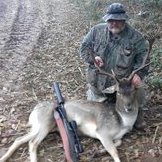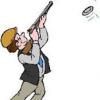-
Posts
1,590 -
Joined
-
Last visited
About clayman
- Birthday 21/04/1952
Contact Methods
-
MSN
jerry@abaclays.com
-
ICQ
0
-
Yahoo
clayman
Profile Information
-
Gender
Male
-
From
Gatwick
-
Interests
Clay target and game tuition
Perazzi MX2 high rib trap
Perazzi MX2 teagued sporting conversion
Perazzi MX8 ported skeet
Nikko Shadow F1 semi
Churchill 25" Hercules Best Boxlock s/s
-
With the improved ballistics of modern cartridges there has been a trend towards lighter and lighter loads, and also to the use of multi-based powders that give lower recoil characteristics. Consequently, second barrel failure when light loads are used on guns with inertia blocks has become more prevalent. I am of the view that owners of inertia block fitted guns should all be aware of the symptoms of a failed discharge from a light load because the recoil did not set the second barrel, and there should be a mainstream procedure recommended for taking the second shot. In my opinion a knowledgeable person undertaking a controlled reset procedure is infinitely safer than an uninformed person taking a non risk assessed correction that may be inappropriate to the cause. What are others views on the acceptable procedures for mitigating an inertia block reset failure? JPY
-
Too low is always a problem. Too high is really a non-existent "problem" - the eye high of the rib is usually a positive advantage. Work out the geometry. The eye 5mm high at the back of the rib, with the barrel length around a meter throws a pattern only 5cm higher for every 10m out to the target, irrelevant in a pattern around 75cm - and that assumes you sight the target through the bead, which you should not ( the usual cause of guns slowing or stopping is "aiming" through the bead). If you have your eye high, you point the gun using the rib in your lower periphery vision at the place you want the shot load to go, with the target in clear sight above the bead. With the eye high of the rib, the shot load rises slightly to centre the clearly visible target that is viewed above the bead. Raising people's eyes off the rib usually has a dramatic positive impact on the score rate - burying your head and "aiming" through the bead will normally have a negative impact on scores.
-
But that the club has commercial cover that may settle a claim, that does not stop the liability running back to the shooter. If you do not carry your own insurance and reply on the clubs, then: Have you read the policy and know the extent of cover? Do you know the premiums are up to date? Is there an excess you might be reponsible for. and finally, if insurance exists at the ground and supports the claim, this means to claiming party is paid out by the ground's underwriters, but having done so what makes you think that they will not seek to re-imburse their settlement from the person/s who caused the claim? For minor claims its probably not worth the administration, but you can be sure they will be knocking on your doorstep for reimbursment if a loss of sight claim for £10,000 was paid out. Whatever cover you might have under a club's policy will be bare bones. You will not have any legal cover to represent yourself within a claim, no license revocation, no personal accident. Remember, club's policies are to cover their negligence, not your negligence as a shooter. If you as a shooter on that ground cause a claim to arise, and the claimant claims on the club policy, loss adjusters will only pay out if you as the person causing that accident can prove negligence on the part of the club i.e. unsafe stands, no controlling public access, etc etc. If their is no fault by the ground, loss adjusters will recommend the claim is not met, and the claimant will be directed straight to you. To then engage the club's insurance to settle the claim, you will need to sue the club, or if you are sued, to join them in the action. When you can carry your own insurance for between £25 and £70 depending on the organisation, it would seem foolhardy to think that because a club has cover, that it comprehensively covers you against potential claims. Afterall, the minimum cover the club needs to hold is employee's liability cover. Have you actually looked to see whatever cover they have is extended to shooters? and if so what are the terms of that cover?
-
Nice to be endorsed, but I would also comment that 1hr lessons are not enough. The problem is that you can fix within the lesson, but there is not enough repetition within an hour, you'd be lucky to get 50 shots away after the fitting process. and that would be a rushed one. I generally take 1 to 1 1/2 hours to get the eyes tested, fit correct and take the client through stance and mount. And remember, a competent shooter will have a set of different starting points for the gun according to the shooting method they will employ for the shot to be taken, and the angle of the flight line. eg, the mount for a high pheasant is different (Stanbury method) from a close crosser (Pull away method), and different again for a quartering bird taken Move Mount Shoot, aka Biddy's method. I define and teach 4 gun down and gun up sporting mounts, gun up trap mount, and three different mounts for skeet according to which stand - plus O/S and FITASC have their own mounts. I cannot provide a comprehensive gun fit followed by instruction in methods and mounts in less than about 4 hrs and generally use 6 hrs so as to be able to get 200 targets or so out and enough repetition that the correct swing and mount becomes consistent and sufficiently established in the sub concious that its not immediately lost in memory after the lesson. Unfortunately, 1 hr / 50 targets usually gets thins sorted with the instructor present, but the mount errors will immediately return the next time the shooter goes out as the new mount method will not have established itself sufficiently in the automated responses in the sub-conscious. To benefit from a gun fit, the shooter needs also to establish correct, but totally instinctive and reactive, swing and mount. You cant do this in an hour, master classes are the only way - i.e. all day sessions with 200 - 300 targets. A series of 6 x 1 hr, will not be as effective, as the shooter improves in the lesson, and slips back when out shooting without the instructor, so its two steps forward, one back, with short time-scale lessons.
-
I am slightly baffled here. Every-one's SG Sec 2 license has the procedure for a sale / purchase clearly written in the notes. Do EXACTLY what it says and no criticism can be made. Where does it say " cross through a sale". Its amazingly simple - do what it says on the license and you have complied. Do anything else and risk, at worst, gun seizure, revocation, prosecution, fine or custodial sentence. Your certificate is Crown Property, and to tamper with it a criminal offence. It says the seller must complete the buyers table and date and sign it - then both parties must report the sale / purchase. Nothing else. Why are people tying to invent procedure that is neither specified nor needed?
-
An entry on a certificate is an authority to be in possession of, not a statement of ownership. As such, it does not need to be qualified on your license as the guns possessive whereabouts is recorded on the National Register as soon as reporting of the sale completes, so no action beyond completing a sale entry on the buyers certificate and reporting is needed by the seller
-
This is the key. 90% of my clients that have either had a gun fitted or are contemplating this don't know how to get stance and mount correct to benefit from the fit. Correct dimension guns held poorly don't fit! Also, this is not an exact science, and what one expert considers correct fit does not match another's views. A colleague of mine reports that he makes a good living undoing work of of well known fitter, so if you are actually getting stock work done - choose your fitter carefully. Also, the ICSI had an investigation by a group of experienced instructors and coaches a few years back, and the conclusion was 2/3rds of gun owners needed stance / mount / technique - not fit. If fit is actually what's needed it should follow.
-
Lewis made some nice guns, I've had two pass through my hands - round actions ( on mine), good balance, nice hand engraved scenes. While they have no particular value premium over other guns of the period from small makers, they are aestheticly nice and worth preserving if you can. Hand made parts cost, as reflected by others, a small fortune, V spring and an extractor part for a Thomas Bland cost £350 to me recently as an example. G E Lewis Guns from his workshops in Loveday St , Birmingham, run from 1859 to 2nd WW period George Lewis was originally just an engraver and there are examples of other makes engraved in their workshops - hence the fact these guns show quality engraving - this was their core business, and you might well find they were finishing guns bought in the white and branding them ( a common practice then and now ) - so a bit of research could throw up other identical guns under other makers names, possibly making a spare easier to locate from a wider group of makers sharing production, but individually finishing them.
-
Made 1966 to 1996 - mk 1 and Mk II versions ( early had short exposed chokes, later had longer flush ones) - imported and rebranded to UK as the No 2 Lincoln by David Nickerson of Louth. Average gun about is now 30yrs old, and out of production for 20yrs, so parts is a big issue - no original spares left and if you need bits they have to come from a donor gun being broken, or be made. Should it be an issue, we have aftermarket manufactured firing pins and chokes for both - but thats all I know thats available for these.
-
Not in your area, but use Parcel Farce to send to Airgun Doctor - best there is.
-
Nice to still be a "lad" at 63 !! Thanks for heads up guys
-

Irate townies living in the countryside
clayman replied to Redditch's topic in General Shooting Matters
The Highways act does not preclude shooting over a public highway - only if it will cause distress, ie frighten horses etc. So its perfectly in order to shoot over footpaths etc if there are no users on it. Also, a walker / rider etc may only progress on a footpath, they cannot deliberately linger in such a way as too interfere with the shooting, nor may they wander off it to interrupt your legitimate activity. -
There are a few great skeet guns with unfashionable <28" barrels which are very well built, but not being fashionable they are very good value for money. The same actions with 30" M/C will have depreciated far less - so these skeet guns can be bargains. Look out for the Browning equivalents, and Nikko skeet guns, as well.
-
Temp certs main purpose is for things like executors to hold guns in probate until disposal etc. Joe dies, widow is granted a Temp and holds they guns in Joe's old cab until they are moved onto a sec 2 users cer when probate is proven - and other similar situations. They were not designed to issue for "gaps" in certificate issue, but are used by some forces for this purpose. Others approach this as , if your application has been received, and has not been rejected, that any administrative delay to re-issue means the old cert is effectively extended, A comment on the Hampshire Firearms Consultative Committee on which I sat, by the then Chief of Firearms for that county at the time, was that if an applicant had submitted an application in time, but for admin reason a new one has not been issued, was that the force could not prosecute some-one for a fault created by their own delays, and any court would through it out even if it got past CPS. They are not designed to allow use or normal trade. It means they are legally in your possession, but not available for normal use. How-ever the "deemed" extension would allow this and any the technical breach of the Act would be unenforceable in his view.
-

Irate townies living in the countryside
clayman replied to Redditch's topic in General Shooting Matters
Couple of comments - there is no "law" that specifies any distance ( other than the centre of a Highway regulation, not relevant here). The NGB of clay targets, the CPSA determined in the 1930s by firing shot down the canal nr the Eley works that 300yds seemed to safely exceed max distance of travel. This was metrified to 275m and adopted by Police etc as a std rule for things like sec 11.6 permits etc. In 2005 the CPSA decided the ancient 300yd/275m rule had no scientific basis, and could prove difficult in a law case, so they and other interested parties funded Dr Allsop to do a scientific paper at Shrivenham ranges. He determined that shot 6 travelled 210m, 8s and 9s < 200m. Windage was determined to add up to 50m drift, forward and sideways.The cpsa adopted a dual rule of Nos 6 - 7.5 stayed at 275m, but, subject to an inspection and risk assessment a dispensation could be granted for 8 - 10s ( ie mainly for skeet) and these could be used in a 250m range. The best defence is to the uninformed is to have a Risk Assessment prepared, which you have copied to the local council EHO. That's who is more likely to respond to a complaint, and if this clearly shows your arc of fire to 275m falls entirely within the permission land, and does not cover any public access points, ie bridleways etc, it is probable he will simply tell the complainers there is no basis for action, as mere annoyance has no legal basis for stopping you shooting. Its also fair to comment that many complainers only do so because they are not pre-informed of shooting activities about to take place. Circulating to housing within about 1/2mile that you have a consent, and these are your contact details, and this is when we might shoot, means no nasty surprises for unsuspecting shoot neighbours, and they can plan social activities around shooting activity if its sensitive.





